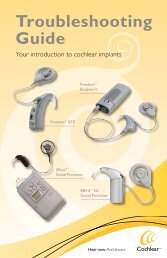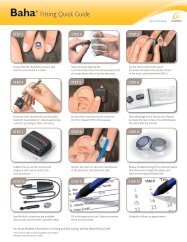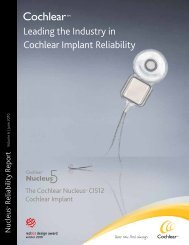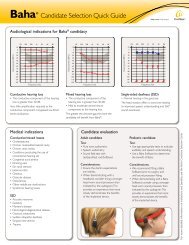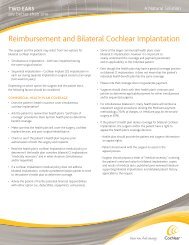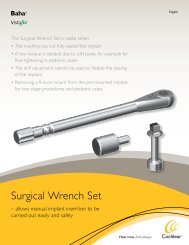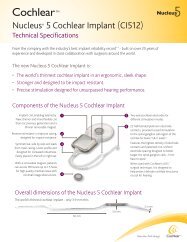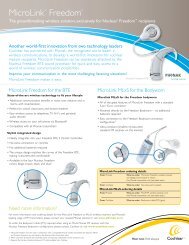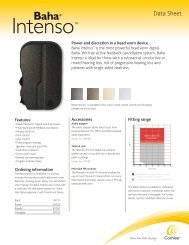Living with your Baha® - Cochlear
Living with your Baha® - Cochlear
Living with your Baha® - Cochlear
Create successful ePaper yourself
Turn your PDF publications into a flip-book with our unique Google optimized e-Paper software.
Your quick guide to<br />
Baha ® Cordelle II<br />
u Connector cable: Connect the straight plug to the head-worn unit and the<br />
angled plug to the body-worn unit.<br />
v Volume control and On/Off button: Move the wheel to turn <strong>your</strong> sound<br />
processor on or off and to increase or decrease the volume.<br />
w Tone switch: The tone switch controls the frequency response of the sound<br />
processor. It can be set in three different positions:<br />
N=Normal. Amplifies all frequencies equally.<br />
H=High frequency emphasis. Reduces low frequency sounds which may<br />
improve speech understanding, especially in background noise.<br />
L= Low frequency emphasis. May be especially useful during the first period<br />
after fitting as it allows you to gradually get used to high frequency sounds<br />
you have not heard for a long time.<br />
x Built-in telecoil<br />
y Direct Audio Input for connecting audio accessories<br />
U Program switch: M= Microphone, MT=Microphone and Telecoil, T=Telecoil<br />
V Flip-up battery cover: When changing the battery, remember to use 9V<br />
batteries only. Make sure the plus-mark on the battery is facing the plusmark<br />
on <strong>your</strong> body worn unit. Don’t force the door shut, as it could break.<br />
Note: Never adjust the potentiometers W as this may void <strong>your</strong> warranty.<br />
Consult the Baha ® Cordelle II User Manual for more detailed information.<br />
Note: Baha ® Cordelle II not shown in actual size.<br />
u<br />
v<br />
w<br />
x<br />
y<br />
U<br />
W<br />
V<br />
What to expect from <strong>your</strong> batteries<br />
Which battery to use (type 13, 675 or 9V) will depend on which Baha sound processor you are using. Just<br />
remember that for the smaller type 13 and 675 batteries, the battery will begin to drain once you remove<br />
the plastic strip – even if the sound processor is not actually in use! The batteries delivered <strong>with</strong> <strong>your</strong><br />
sound processor reflect <strong>Cochlear</strong>’s latest battery brand recommendation.<br />
There are a number of factors that affect battery life. Brand type is one factor; low temperatures and<br />
hourly use are others. The program and volume control settings – as well as the use of accessories such as<br />
FM equipment – can also affect the life of the battery. Be sure to use only new, high quality batteries as<br />
this gives the best sound performance.<br />
testing type 13 and 675 batteries<br />
To test the battery, place it in the tester (provided in <strong>your</strong> Aftercare Kit)<br />
<strong>with</strong> the plus-mark facing upwards, and press it onto the metal band. The<br />
display screen will then indicate how much power is left. The more bars<br />
there are, the more power is left in the battery.<br />
20 21



